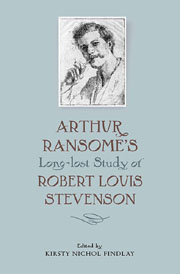Introductory
from Arthur Ransome, Robert Louis Stevenson: A Critical Study
Published online by Cambridge University Press: 05 February 2013
Summary
The book, as I see it now, should be really two books. The one should be the plain tale of an adventurous romantic's progress through life in the nineteenth century; and the other should be a kind of log-book, kept by the clerk of a workshop, retaining perhaps a little of the abridgement and hurried character of notes made in the whistle and hum of the machinery, its pages smudged a little with iron filings, and here and there a shaving to keep the place. It should, I think, retain the sharp clean smell of new sawdust. And yet, different in character as the two books should be, it ought not to be possible for the reader of the tale to forget that its hero was, in fact, prospecting for metal and timber that was afterwards to go into the workshop, and the reader of the mechanic's record should be reminded that he who wrestled so merrily with the problems of machinery, was also the man who sailed and rode and played at being a consul away in the South Seas, and, in earlier manhood, had walked on Princes Street, exultant in his youth, and from the Calton Hill had swelled at the vision of the town beneath him, and in wild northern seas3 had done his day's work with the rest.
Stevenson, perhaps more markedly than any other Scottish writer born in the nineteenth century, stands a little apart from English literature.
- Type
- Chapter
- Information
- Publisher: Boydell & BrewerPrint publication year: 2011



